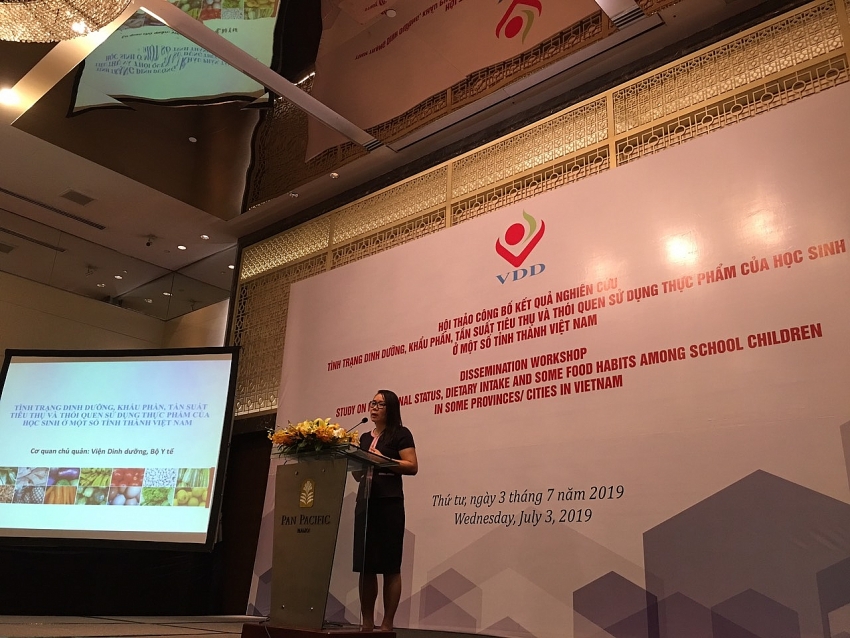NIN shows shortcomings in nutrition and physical activity in children
 |
| Report of NIN shows shortcomings in the aspect of nutrition and physical activity in children of different ages |
On July 3, 2019, the National Institute of Nutrition (NIN) held a workshop disseminating the findings of the report of the study on nutritional status, dietary intake, food consumption frequency and habit of Vietnamese students.
The study has shown the shortcomings in the nutrition status and physical activity of children of different ages. According to the study, primary school students’ energy and protein intake was beyond the recommended dietary allowance (RDA), however, they have a low physical activity level, leading to a high rate of overweightness and obesity, especially in urban areas. Meanwhile, secondary and upper secondary school students’ intake has not reached the RDA for energy, iron, zinc, various types of vitamins, resulting in a high rate of malnutrition in lower and secondary school students.
Speaking at the workshop, Associate Professor Dr Truong Tuyet Mai, deputy director of NIN shared, “Students make up more than a quarter of the nation's population and they represent the future of the country. The implementation of intervention programmes in schools generally and school nutrition particularly is critical in order to improve the stature and fitness of the Vietnamese people. NIN conducted this study to have a big picture of the nutritional status of students, to be able to propose appropriate solutions to improve risk factors and nutritional status for students in the next period; improve the stature, intelligence, and health of Vietnamese people, and provide high-quality human resources to contribute to the development of the country.”
The study also points out some factors related to obesity including age, gender, area, socio-economic conditions, and education level of parents. Factors related to diets and living conditions also contribute to increasing obesity. Sitting in front of a screen and consuming more soft drinks and sugary drinks increase the rate of obese and overweight students. It is worth noting that the study shows that non-overweight/obese group tends to consume more industrialised soft drinks and sugary foods than the overweight/obese group.
In contrast, the overweight/obese group consumes more sugary drinks sold on the street than the non-overweight/obese group. According to the study, the frequency of consuming sugary drinks sold on the street is a factor that increases the risk of obesity and overweightness in high school students by 1.4 times.
At the workshop, Associate Professor Dr Tran Thuy Nga, research specialist of NIN, who is the chair of this study project, made the following recommendations, "It is necessary to orient intervention programmes to prevent malnutrition among children in rural areas and obesity in urban areas, and to enhance school-based educational communication on balanced and reasonable healthcare and nutrition. In addition, families, schools, and government departments need to create favourable conditions for children to have healthy and balanced meals, to create a playground for children to exercise and play sports, and to ensure that children sleep enough each day.”
The study was conducted over 12 months on 5,028 students from 7 to 17 years old at 75 schools in Hanoi, Ho Chi Minh City, and Thai Nguyen, Nghe An, and Soc Trang provinces.
| Key findings of the study include - The prevalence of overweight and obesity gradually decreases with the age of students and there are big discrepancies among areas; - The overweight/obese group tends to consume a lot of high-protein foods while the non-overweight group tends to consume industrialised soft drinks and sugary foods; - Overweight and obese students tend to use all categories of food at a higher level than non-overweight students; - The physical activity level of students is inversely proportional to nutrition and energy intake. |
What the stars mean:
★ Poor ★ ★ Promising ★★★ Good ★★★★ Very good ★★★★★ Exceptional
Related Contents
Latest News
More News
- Businesses ramp up production as year-end orders surge (December 30, 2025 | 10:05)
- Vietjet chairwoman awarded Labour Hero title (December 29, 2025 | 13:06)
- How to unlock ESG value through green innovation (December 29, 2025 | 10:03)
- AI reshapes media and advertising industry (December 29, 2025 | 08:33)
- FPT and GELEX sign deal to develop blockchain tech for global markets (December 29, 2025 | 08:29)
- Vietnam’s GDP forecast to grow by 9 per cent in 2026 (December 29, 2025 | 08:29)
- Women entrepreneurs are key to Vietnam’s economic growth (December 29, 2025 | 08:00)
- Vietnam's top 500 value-creating enterprises announced (December 27, 2025 | 08:00)
- The PAN Group shaping a better future with ESG strategy (December 26, 2025 | 09:00)
- Masan Consumer officially lists on HSX, marking the next phase of value creation (December 25, 2025 | 13:20)

 Tag:
Tag:




















 Mobile Version
Mobile Version